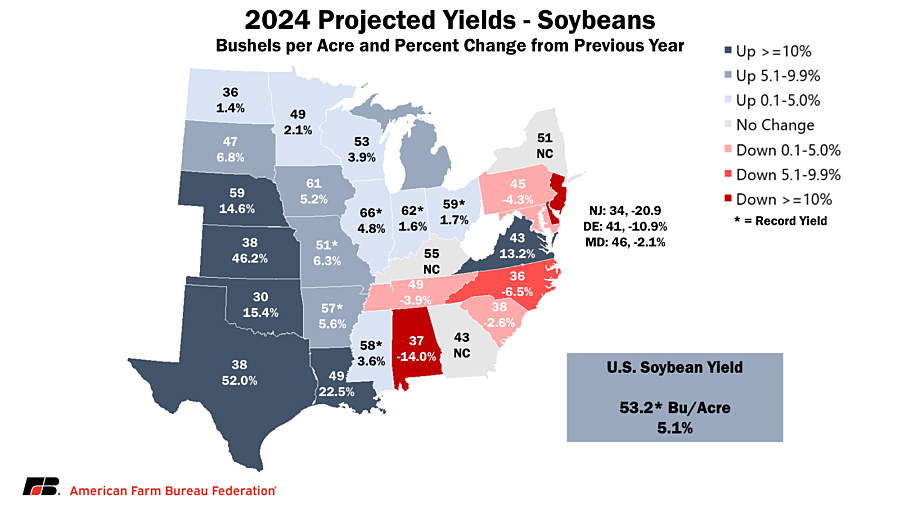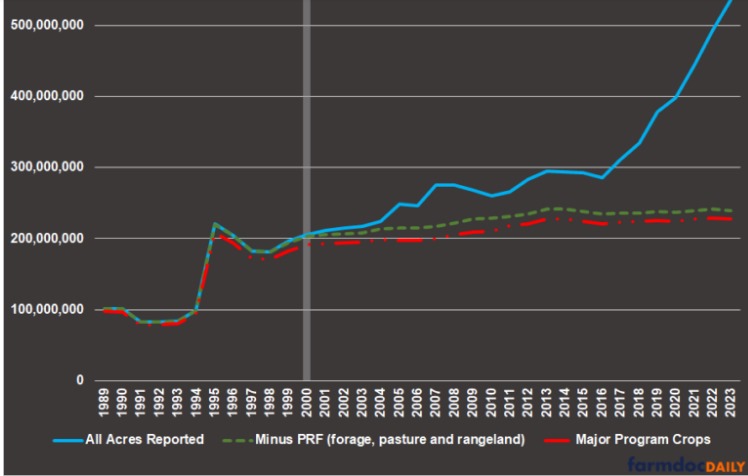
Since 2000, the U.S. corn-to-soybean ratio has averaged 3.49, with much variation around that average. The highest U.S. ratio of 4.19 occurred in 2003 when soybeans were particularly hard hit by aphids and other pest infestations. The lowest ratio of 3.08 occurred in the 2012 drought year. The extremely dry weather in 2012 had larger adverse impacts on corn, with rain occurring in August helping soybean yields. Statistical tests suggest that the corn-to-soybean ratio has not been trending up or down since 2000.
Figure 2 shows corn-to-soybean ratios for states in the greater Midwest. Year-to-year, there is variability in corn-to-soybean ratios across times and states. While yield ratios may not have trended between 2000 and 2024, the level varies distinctly by state.

Variations in Ratios by State
To evaluate differences in relative corn and soybean yields, we calculated corn-to-soybean ratios across the states in the greater Midwest. Corn yields, soybean yields, and corn-to-soybean yield ratios were calculated and averaged for the five crop years from 2020 to 2024 (see Figure 3).

As expected, states with higher average corn yields also tend to have higher soybean yields (see Panel A of Figure 1). Illinois had an average corn yield of 206 bushels per acre from 2020 to 2024, the highest in the nation. Illinois also had the highest soybean yield for the same period of 63 bushels per acre. On the other hand, Kansas and North Dakota had lower corn yields: 133 bushels per acre for North Dakota and 127 for Kansas. North Dakota and Kansas also had the lowest soybean yields, averaging 34 bushels per acre. Overall, a strong, positive relationship exists between average corn yields and average soybean yields.
While corn and soybean yields are positively related, the corn-to-soybean ratio (relative yields) negatively correlated with corn yield. That is, corn-to-soybean yield ratios tended to decrease with corn yields. For example, Kansas had an average corn yield of 127 bushels per acre while having a 3.84 yield ratio, one of the highest. The only state with a higher corn-to-soybean yield ratio was North Dakota, with a 3.98 ratio. North Dakota also had the second-lowest corn yield of the Great Plains states. In contrast, Illinois has one of the lowest yield ratios at 3.30 while having the highest corn and soybean yields of the state considered. The relationship between the yield ratios and yields (relative vs. absolute yields) is driven by the relative variability in corn and soybean yields across the states. Illinois corn yields are 62% higher than Kansas corn yields (206 bushels per acre / 127 bushels per acre – 1). Illinois soybean yields exceeded those for Kansas by 85% (63 bushels per acre / 34 bushels per acre – 1).
Summary
While corn and soybean yields have increased over time, corn-to-soybean yield ratios generally have not trended up or down at the national or state levels in the 21st Century. However, there does exist variation in relative yields across states. States in the central Corn Belt region (Illinois, Iowa, Indiana) tend to have higher corn and soybean yields than states in the western Corn Belt and Great Plains (Kansas, North Dakota). In relative terms, as measured by the corn-soybean yield ratio, corn is relatively more productive (higher yield ratios) in the states with lower average corn and soybean yields.
Source : illinois.edu